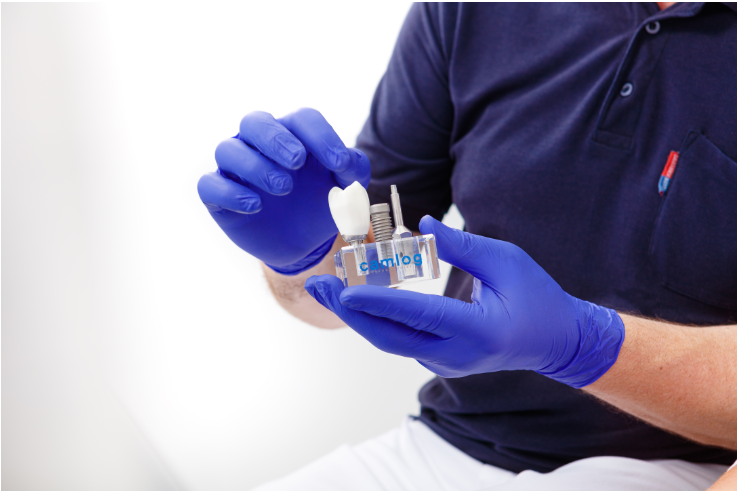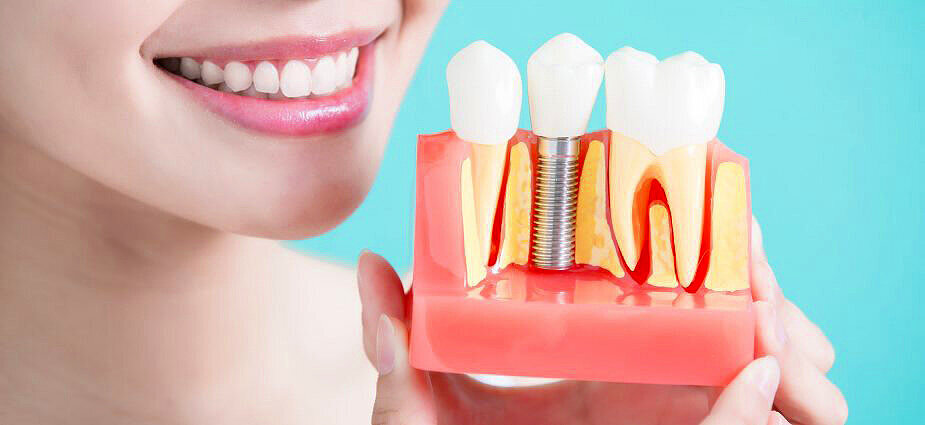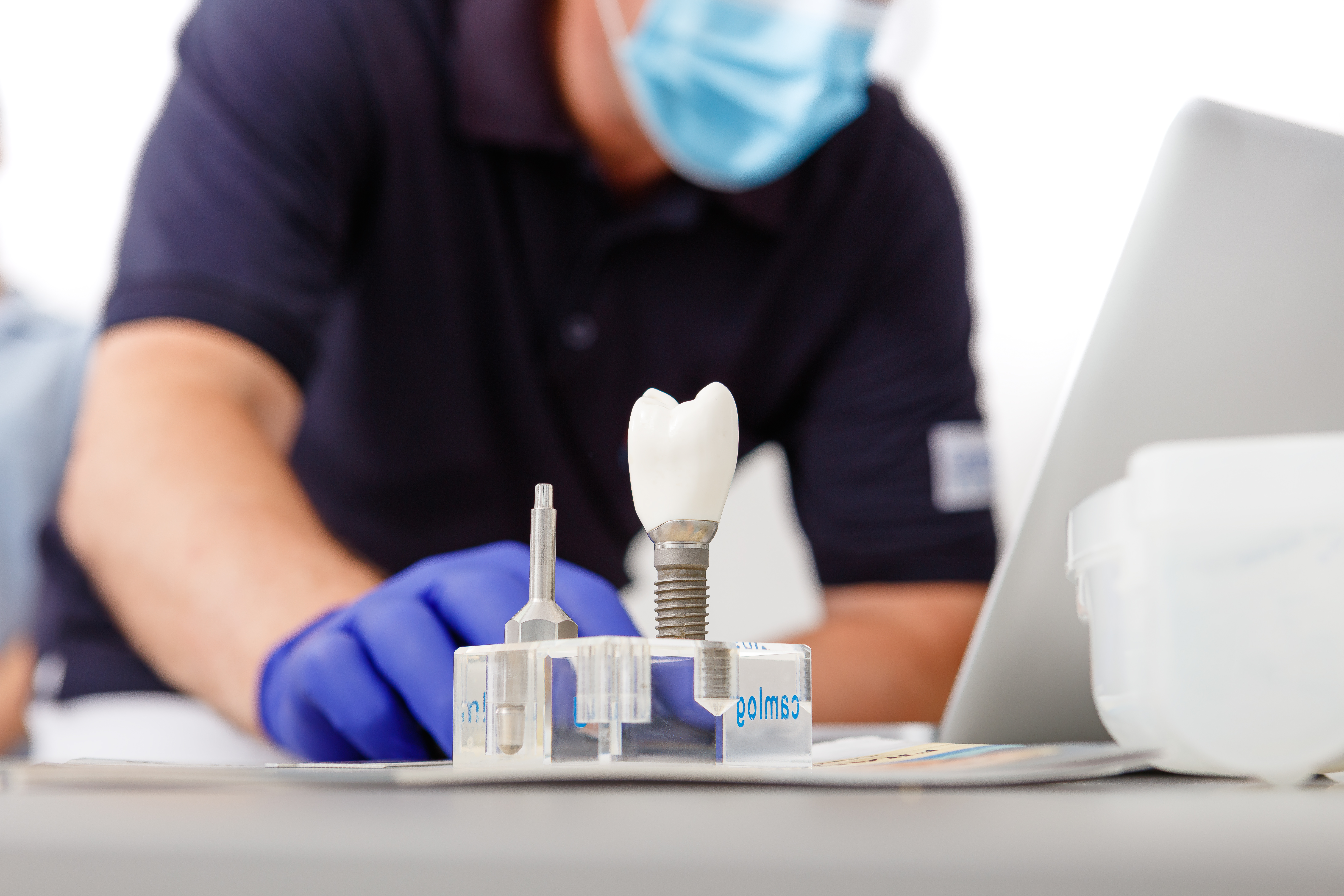Perfectly personalized denture – Flexible implementation process – With the latest tools
Surgeons: Dr. Óvári Zoltán; Dr. Gschwindt Sebastian; Dr. Kondrács Márk; Dr. Ruzsa Ádám
The implant, or
also known as dental implantation
The dental implant is an ‘artificial root’ that replaces the root of missing teeth or the teeth which need to be extracted. For this artificial root/implant, a dental crown that perfectly mimics the shape, color, and functionality of the original tooth can be made, or – in the case of multiple missing teeth – a different fixed dental prosthesis.
This is a durable and frequently used solution, with which the absence of teeth can be eliminated or a tooth intended for removal can be replaced in a way that most closely resembles one’s own teeth. Most commonly made of titanium, but in certain cases, metal-free (zirconium-based) implants can also be placed.
Important: It is advisable to plan the tooth replacement before the tooth extraction. Often, the best aesthetic and biological results can be achieved with immediate implantation and immediate tooth replacement. Of course, there is also the possibility of replacing missing teeth with implants in the case of already existing tooth gaps.
Important: with implants, it is possible to achieve a more stable fixation for partial or complete dentures (prosthetics), or even create a fully fixed dental replacement, regardless of age.


What are the advantages of dental implants?
It looks and feels just like a natural tooth.
When replacing a missing tooth, there is no need to grind down the neighboring teeth, allowing for restoration without damaging them.
Even in the case of extensive tooth loss, removable dentures/prosthetics can be avoided, Removable dentures/prosthetics can already be securely fixed with a few implants.
With implants, bone resorption and gum shrinkage can be prevented after tooth extraction. This is particularly true for immediate implantation, when the implant is placed at the same time as the tooth extraction.
Important: before having a tooth removed, it is advisable to have the plans for tooth replacement prepared.
Important: medical consultation is necessary before starting treatment for osteoporosis.
What is the procedure of the treatment, what tools, what techniques are used?
The most important initial step in implant treatment is proper planning. It is a significant help that in our practice, all the diagnostic tools necessary for planning are available (X-ray, CBCT, computer-aided design software), as well as a dental laboratory.
Since the primary goal is not the implantation of an ‘artificial root’ but rather the creation of a naturally looking and functioning tooth or set of teeth, the position of these teeth must be planned first. The position, shape, and size of the future teeth then determine what type of implant is worth choosing and where it needs to be placed.
The long-term success of dental implants depends on the same conditions as with natural teeth, namely that they are surrounded by a sufficient amount of bone and stable gum tissue. If these tissues have been absorbed or altered in the area of tooth loss, their regeneration is also necessary for a successful implantation. Depending on the extent of the restoration’s necessity, it can be done either at the same time as the implantation, prior to it, or in certain cases, after a successful implantation.
Step-by-step guide to implant treatment
Since dental implantation is a surgical procedure and the area remains as vulnerable as a natural tooth afterward, there are very rare exceptions when the surgery is not feasible. This includes certain medications, drugs used for osteoporosis, and numerous risk factors, where it is important to reduce their effects (periodontal disease, smoking, diabetes) considering their impact.

Step 1.
Consultation and assessment at the dentist – planning for permanent dental restoration. Preparation of the temporary crown to be placed at the time of implantation simultaneous with tooth extraction.
Step 2.
The implant is placed, 100% painlessly. If necessary, with computer-aided design, using an implant drilling template made in our own laboratory. In the case of tooth extraction, often with an immediately prepared fixed, temporary crown.
Step 3.
After the healing period (2-6 months), the construction of dental crowns or bridges take place. The new, permanent teeth are then placed on the previously placed implants.
Take care of your teeth!
Do you have a question? Write to us!
Dental replacement options with implants

A single missing tooth can easily be replaced with a single tooth crown implant.

A dental bridge (3 crowns supported by 2 implants) is used to replace 3 missing teeth.

For full mouth restoration, we use a stable denture that is secured to implants.
Bone graft, gum graft for implantation
There are safe and painlessly executable methods for replacing significant bone loss. The limit is generally not the extent of bone loss but the general surgical risk factors, such as certain medications, underlying diseases, or harmful habits.
If there are no contraindications for bone grafting, in most cases, a bone substitute material (the inorganic matrix of animal-origin bone in the form of small particles) and a mixture of the patient’s own bone are used. In most cases, the patient’s own bone is harvested in the form of bone chips either from the surgical site or separately within the oral cavity, opened specifically for bone grafting purposes, or using special drills also in granular form.
We secure this bone mixture with absorbable ‘membranes’ in areas where we want to replace bone. Tiny titanium screws hold the membranes in place, and sometimes a titanium framework helps maintain their shape.
During the healing period, the patient’s own bone grows into this constructed area, and the planned implant can be placed in it later.
One special form of bone grafting is the so-called Sinuslift. It is used when there is not enough bone in the upper jaw for implantation because the sinus is too close to the tooth roots. In such cases, we lift the mucous membrane layer covering the sinus from the inside (which replaces the membrane described above), and we place our bone substitute material underneath it. Depending on the extent of bone loss over the sinus – also with intraoral access, completely painlessly – we create a lateral bone window, or we simply lift the mucous membrane through the planned implant hole and introduce the bone substitute material.
Treatment under general anesthesia or sedation
The main advantage of dental procedures performed under general anesthesia or sedation is that patients can undergo treatment completely pain-free, eliminating concerns about fear or stress-related symptoms. The actual treatment is always preceded by a consultation with a specialist and an anesthesiology consultation. While no preliminary examinations are required for sedation, general anesthesia necessitates a comprehensive lab test, EKG, and chest X-ray. After the treatment, the patient can only leave the clinic accompanied by an escort.
Would you like to have your treatment done under general anesthesia or sedation? Schedule an appointment for a specialist consultation, during which you will receive detailed information about both sedation options.
Articles on the topic
Our Patients Said
“For a while, I struggled a lot with my teeth, experiencing significant pain. However, a huge change happened after visiting CosmoDent. They solved my problems quickly, precisely, and painlessly! Professional team!”
Dóri
In the last two weeks, my wife and I visited you several times for check-ups, cleanings, and each of us had a filling done by Dr. Vivien Farkas or Márta Nagy. We would like to give feedback that we were very satisfied with the treatment. We are grateful for the helpful advice. The atmosphere at your clinic was very pleasant. It was great to experience how well you cared for us, without overdoing it. Although we don’t usually stress about going to the dentist, I noticed that the last time we went to you, we were completely relaxed, which I think is very cool considering that many people don’t like going to the dentist. We wish you continue to provide your service so beautifully!
Young Budapest Family
“I have been very satisfied with the services of Cosmodent for 16 years now. Extremely knowledgeable doctor team, modern technology, kind service, attention to detail.
I highly recommend the Team after numerous dental interventions.”
Réka
“The equipment and knowledge are unique at the clinic. I have been to many places, but I have never experienced such care! I came home with a bigger smile than I arrived with! Thank you!”
Ágnes
“It seemed like all my teeth had to be pulled out. However, after a thorough examination, it turned out that most of my teeth could be saved. The whole team, especially my dentist, Dr. Peter Rosta, made a great effort and did a fantastic job. I am already full of positive expectations for the next stage of my treatment, when I will get the implants. I really hope that after the complete treatment, I will have an aesthetic and, above all, functional set of teeth again.
I can only recommend the team at Cosmodent to everyone!”
Thomas
“I received the most thorough, attentive treatment at the dental clinic. I am completely satisfied. I will choose CosmoDent again for the next time!”
Erzsébet
“I really liked the new dental office. The new environment is very nice, the design of the dentistry gives the impression that one is in good hands. The employees there are very sympathetic, kind, and attentive. The hygiene is impeccable, which is a very important factor for dentistry even in this Covid situation. Overall, I recommend it to anyone who hesitates where to go.”
Aliz
“I have been to Cosmodent Dentistry for tartar removal treatment several times, performed by Éva Kriston. The treatment was thorough and painless, and Éva was kind and answered all my questions willingly. I will choose Cosmodent in the future as well.”
Kriszti
We apply various treatments thoughtfully, so we find the right one for everyone
- Through a thorough examination, we establish an accurate diagnosis.
- We consult with you to create a comprehensive treatment plan.
- Diagnostics, specialists, and dental technology all in one place.









